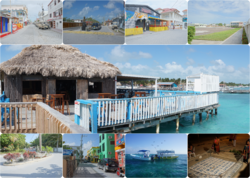San Pedro Town
| San Pedro Town | |
|---|---|
| Town | |
| Town of San Pedro, Ambergris Caye | |

San Pedro Collage.
|
|
| Nickname(s): La Isla Bonita | |
| Map of San Pedro metropolitan area | |
| Coordinates: 17°55′17″N 87°57′40″W / 17.92139°N 87.96111°W | |
| Country |
|
| District | Belize |
| Constituency | Belize Rural South |
| San Pedro | 1848 |
| Government | |
| • Mayor | Daniel Guerrero (UDP) |
| Area | |
| • Total | 71 km2 (27.5 sq mi) |
| Elevation | 2 m (7 ft) |
| Population (2010) | |
| • Total | 11,767 |
| • Estimate (2015) | 16,444 |
| • Density | 170/km2 (430/sq mi) |
| Demonym(s) | San Pedrano(a) |
| Time zone | Central (UTC-6) |
| Climate | Aw |
San Pedro is a town on the southern part of the island of Ambergris Caye in the Belize District of the nation of Belize, in Central America. According to 2015 mid-year estimates, the town has a population of about 16,444. It is the second largest town in the Belize District and largest in the Belize Rural South constituency. The once sleepy fishing village was granted the status of a town in 1984 and was sometimes said to be the inspiration for the song "La Isla Bonita" (which begins with the line "last night I dreamt of San Pedro"), written by Madonna, Patrick Leonard and Bruce Gaitsch.
San Pedro's inhabitants are known as San Pedranos. Most speak both Spanish and English fluently. Due to the influence of Kriol, most San Pedranos can speak it, as well as an intermediate form that is known as "Kitchen Spanish". It is said one is not a true San Pedrano if one doesn't know how to fish.
The refugees from the "Guerra de Castas" fled mainly south to the sanctuary of northern Belize where the British authorities gave them protection and encouraged them to settle. This was done in the hope that the refugees would eventually establish an agricultural settlement in Corozal, and provide the lumber camps with an alternative source of foodstuffs now that the supplies through Bacalar were no longer available.
This migration was the principal factor in the settling of northern Belize. The population grew from less than 200 in 1846, to 4,500 inhabitants by 1857, to 8,000 in 1858, in the Corozal District alone. According to the official census in 1861, the population of the northern section of the country was almost twice that of Belize City and the surrounding areas.
...
Wikipedia

